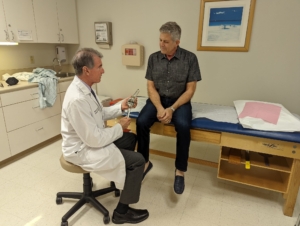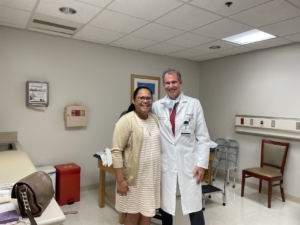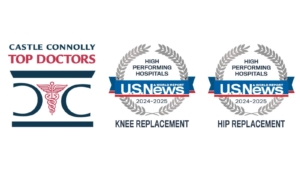Holy Cross Orthopedics
What’s Your Knee Replacement IQ?
(Second of a three-part series)
This is the second “quiz” in a three-part series designed to test your knowledge. Our hope is to inform, educate and give you confidence with proceeding to have a total knee replacement. At the Leone Center we repeatedly see that patients who go into surgery more prepared and more knowledgeable have a better experience and get well faster.
There are 7 TRUE or FALSE questions followed by expanded answers.
On our website (holycrossleonecenter.com) you can download our helpful booklet “Preparing For Your Knee Replacement” filled with step-by-step information.
We are a concierge practice with a personalized approach that begins with the first phone call and continues throughout your care. No crowded waiting rooms and rushed meetings with Dr. Leone or his entire team. We model our care according to the way we would want our own families to be treated and that means that only the best will do.
True or False?
- A multimodal approach to pain management often includes a spinal anesthetic, a local nerve block, as well as infiltrating the tissues around the knee with a “cocktail” of different medicines designed to stay ahead of the pain curve by decreasing and preventing pain.
- During knee replacement surgery, the surgeon removes damaged cartilage and bone from the knee joint and replaces it with man-made material.
- Despite the anesthesia, you will have pain after the surgery.
- Many patients go home several hours after knee replacement surgery.
- Most people need physical therapy either at home or in a rehab center to strengthen their limbs after knee replacement surgery.
- Most total knee replacement patients require more physical therapy than total hip replacement patients.
- The amount of physical therapy you require after surgery often depends on how physically fit you were before surgery.
Answers:
(8-14) True, True, True, True, True, True, True

- TRUE: The Leone Center uses a multimodal approach to treating pain which often includes a spinal anesthetic, a local nerve block, as well as infiltrating the tissues around the knee with a “cocktail” of different medications designed to stay ahead of the pain curve by decreasing and preventing pain.
The Leone Center’s multimodal approach and philosophy to treat and prevent post-operative pain has made a wonderful difference so that routinely patients are walking just hours after their surgery with nearly everyone going home later that day or the next. This can only happen if people are comfortable and confident.
Thankfully, so many historic complications that routinely occurred after knee replacement surgery are now rare, such as nausea with vomiting, confusion, and delayed ability to get out of bed, walk and rehabilitate. Rarely do our patients develop blood clots, skin breakdown or blisters, and even the need to go to a rehabilitation facility rather than go home has become a rarity.
These dramatic improvements have occurred because of specific strategies to prevent and down-regulate pain. These strategies start before surgery, continue with specific techniques and medicines used in the operation room, and continue with our protocols after surgery. After surgery, our patients receive medicines from different classes of drugs that work together which potentiates their effect and are combined with modalities like ice and physical therapy. This avoids the need for “on demand” high-dose narcotics typically administered when someone is in pain rather than stopping pain before the pain ever starts.
Patients are also getting well so much faster than ever before because their knee implants are being more precisely aligned and implanted, and their supportive soft tissues are more accurately and reproducibly balanced using kinematic sensor technology and robotics. Combined, patients are returning to full activities faster and describing their experience more positively.
- TRUE: During knee replacement surgery, the surgeon removes damaged cartilage and bone from the knee joint and replaces it with a man-made material.
Knee replacement surgery realigns the limb, correcting any bowleg or knock-kneed deformity; re-balances the surrounding soft tissue sleeve made up of ligaments and tendons; and surfaces the end of the femur, tibia and underneath surface of the patella or kneecap with artificial parts, so that when the knee moves, the bones no longer rub together and only artificial surfaces touch. The happiest patients and those with the best results are when all of these critical variables are perfectly accomplished, so the new knee moves naturally as it did before the arthritic condition developed.
- TRUE, But highly variable! Despite the anesthesia, you will have pain after the surgery.
The main reason why nearly all of Dr. Leone’s patients are walking just hours after their surgery and going home (not to rehabilitation facilities) the day of their surgery or the next, is because patients are comfortable. The Leone Center’s multi-modal strategies effectively down-regulate and prevent pain. This has been a game changer. There often is still some mild discomfort, although this is highly variable.
Pain is real and varies greatly among different individuals. Some people feel pain intensely and other hardly at all. The fear about having pain after surgery is one of the main reasons folks delay or avoid ever getting surgery.
The Leone Center’s pain management process starts with patients receiving medicines even before their surgery and using specific anesthetic agents and techniques during surgery. After the surgery, patients start walking just hours after their surgery and are instructed to take a variety of different medicines from different classes of drugs, initially on a schedule, along with modalities like ice and physical therapy. Together, it all works.
“I’ve seen in my career this wonderful trend of folks going home sooner and returning to full activities sooner, which is a testament to the effectiveness of our procedures,” Dr. Leone said.
- TRUE: Many patients go home several hours after knee replacement surgery.
“One of the things that has changed the most over the course of my career is how much faster and easier my patients are getting well and returning to full activities in their life than ever before,” Dr. Leone said. “The vast majority of my patients walk just hours after their surgery and go home later that day or the next. It’s been very gratifying to see how quickly they recover.”
- MOSTLY TRUE: Most people need physical therapy either at home or in a rehab center to strengthen their limbs after joint replacement surgery.
Most of Dr. Leone’s patients go home the day of their surgery or the next and The Leone Center arranges for a physical therapist to work with them in their homes. After this, many patients who had a partial knee replacement do not need more formal physical therapy. Most patients who had a total knee continue formal therapy either in their home or at an outpatient facility. Once sutures are removed two weeks after surgery, Dr. Leone encourages them to also exercise, go to their own gym and walk in a pool if available.
Occasionally, some of Dr. Leone’s patients are discharged to an in-house rehabilitation facility, although this has become much less common than in the past. If possible, patients are discharged home with extra help and services. It’s been our experience at the Leone Center that patients who go home rather than a rehabilitation facility get well faster because they do more for themselves, feel safer and are happier.
- TRUE: Most total knee replacement patients require more physical therapy than total hip replacement patients.
Most of Dr. Leone’s patients go home the day of their surgery or the next and The Leone Center arranges for a physical therapist to then work with them in their homes. Most patients really like this.
At two weeks patients return to the Leone Center for their sutures to be removed. Nearly all patients who had a complete or total knee continue physical therapy. Most start outpatient therapy, although some will continue with home therapy. Some patients who had a partial knee stop formal physical therapy. Whether formal therapy is discontinued, continued in one’s home, or in an outside facility, patients are encouraged to walk for exercise. Many resume going to their own gym and if available start walking or swimming in their pools.
In general, patients who have a total knee replacement experience more pain and require more therapy after their surgery than those who undergo total hip replacement or partial knee replacement. Regardless, what is seen routinely at The Leone Center is that when patients return for their six-week post-operative visit, the vast majority are doing so well that they typically are not seen again for several years or more, and then usually only to evaluate something else that they are worried about.
- VERY TRUE: The amount of physical therapy you require after surgery often depends on how physically fit you were before surgery.
“Repeatedly, I see those folks who go into surgery more physically fit, get well faster than patients who are not. Similarly, I also see patients who are more informed and who’ve developed a post operative plan also get well faster and report a better experience.” Dr. Leone said.
At the Leone Center we encourage our patients to do the pre-operative exercises prescribed in Dr. Leone’s Preparing for Your Knee Replacement booklet. These are many of the same exercises that patients are instructed to do after their surgery. These exercises condition and strengthen their muscles before their surgery so they’re easier to do after surgery and resulting in patients recovering even faster. The Preparing for Your Knee Replacement booklet is given to Dr. Leone’s patients before their surgeries and can be downloadable here.
Understandably, patients who are more disabled before their surgery require more time to rehabilitate fully after their surgery. Some individuals are so disabled they can barely walk, others much less so. Some have horribly advanced and deformed arthritic knees and can’t do many of the pre-surgical exercises due to pain or because the knee simply will not move. This is perfectly ok. But there are almost certainly some exercises they can do, like the deep breathing exercise or ankle pumps which we then encourage.
Getting well is a process and at the Leone Center we fully understand and respect this. It’s also individual and some people take longer to get well than others. But they do get well, and that is what’s important.
The Leone Center for Orthopedic Care provides highly personalized, end-to-end orthopedic care for people with hip and knee conditions. Dr. William Leone offers patients the latest, most promising innovations in joint replacement surgery, in a compassionate, patient-focused setting. He has performed over 15,000 joint surgeries over the course of his career, restoring mobility and improving quality of life for thousands of patients from all over the world.
Check out Dr. Leone’s Patient Testimonials. These grateful patients make it all worthwhile.

The Leone Center for Orthopedic Care at Holy Cross Hospital is located at 1000 NE 56th Street in Fort Lauderdale. For more information or to schedule a consultation, please call 954-489-4575 or visit holycrossleonecenter.com.




